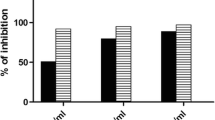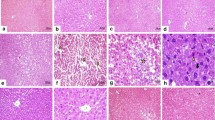Abstract
More than 600 chemicals can cause damage in liver, one of which is carbon tetrachloride (CCl4). Hepatoprotective agents could prevent tissue damage and reduce morbidity and mortality rates; such agents may include alternative or folkloric treatments. We investigated sesame (Sesamum indicum L.) for its hepatoprotective effect in CCl4-induced experimental liver damage. To this end, 0.8 mg/kg of sesame fixed oil was provided intraperitoneally to rats whose livers were damaged by CCl4. Tissue and blood samples were taken at the end of the experiments and evaluated histologically and biochemically. Ballooning degenerations and an increase in lipid droplets in liver parenchyma and increases in serum alanine transaminase, aspartate transaminase, and bilirubin were found in the CCl4 group. Biochemical and histopathological findings in the sesame fixed oil treated group were not significantly different from the CCl4 group. Sesame did not show a hepatoprotective effect in CCl4-induced liver toxicity.






Similar content being viewed by others
References
Al Hamedan WA, Anfenan MLK (2002) Antioxidant activity of leek toward free radical resulting from consumption of carbonated meat in rats. Life Sci J 8:169–176
Awobajo FO, Omorodion-Osagie E, Olatunji-Bello II, Adegoke OA, Adeleke TL (2009) Acute oral toxicity and phytochemistry of some West African medicinal plants. Niger Q J Hosp Med 19:320–329
Bharali MK, Dutta K (2009) Hepatic histopathological abnormalities in rats treated topically with para-phenylene diamine (PPD). J Pharmacol Toxicol 4:221–228
Bhatt AD, Bhatt NS (1996) Indigenous drugs and liver disease. Indian J Gastroenterol 15:63–67
Bhattacharyya D, Mukherjee R, Pandit S, Das N, Sur TK (2003) Prevention of carbon tetrachloride induced hepatotoxicity in rats by Himoliv, a polyherbal formulation. Indian J Pharmacol 35:133–135
Bishayee A, Sarkar A, Chatterjee M (1995) The hepatoprotective activity of carrot (Daucus carota L.) against carbon tetrachloride intoxication in mouse liver. J Ethnopharmacol 47:69–74
Bown D (1995) Encyclopaedia of herbs and their uses. Dorling Kindersley, London
Brattin WJ, Glende EA Jr, Recknagel RO (1985) Pathological mechanisms in carbon tetrachloride hepatotoxicity. J Free Radic Biol Med 1:27–38
Cengiz N, Ozbek H, Him A (2008) Hepatoprotective effects of Pimpinella anisum seed extract in rats. Pharmacologyonline 3:870–874
Duke JA, Ayensu ES (1985) Medicinal plants of China. Reference Publications, Inc., Algonac, MI
Fridovich I (1995) Superoxide dismutases. Ann Rev Biochem 64:97–112
Gassó M, Rubio M, Varela G, Cabré M, Caballería J, Alonso E, Deulofem R, Camps J, Giménez A, Pajares M, Parés A, Mato JM, Rodés J (1996) Effects of S-adenosylmethionine on lipid peroxidation and liver fibrogenesis in carbon tetrachloride-induced cirrhosis. J Hepatol 25:200–205
Goldfrank LR, Flomenbaum NE, Lewin NA, Weisman RS, Howland RS, Hoffman RS (1998) Acetaminophen. In: Smilkstein MJ (ed) Goldfrank’s toxicologic emergencies, 6th edn. Appleton and Lange, Norwalk
Goth L (1991) A simple method for determination of serum catalase activity and revision of reference range. Clin Chim Acta 196:143–152
Handa SS, Sharma A (1990) Hepatoprotective activity of andrographolide from Andrographis paniculata against carbontetrachloride. Indian J Med Res B 92:276–283
Kanno T, Sato EE, Muranaka S, Fujita H, Fujiwara T, Utsumi T, Inoue M (2004) Oxidative stress underlies the mechanism for Ca2+-induced permeability transition of mitochondria. Free Radic Res 38:27–35
Klein AS, Hart J, Brems JJ, Goldstein L, Lewin K, Busuttil RW (1989) Amanita poisoning: treatment and the role of liver transplantation. Am J Med 86:187–193
Lee WM (1995) Drug-induced hepatotoxicity. N Engl J Med 333:1118–1127
Lewis MPH (1977) Medical botany: plants affecting man’s health. Wiley, New York, pp 217–218
Linder MC (1984) Other trace elements and the liver. Semin Liver Dis 4:264–276
Momin A (1987) Role of indigenous medicine in primary health care. Paper presented at: 1st International Seminar on Unani Medicine, New Delhi, India, p 54
Nadkarni GD, D’Souza NB (1988) Hepatic antioxidant enzymes and lipid peroxidation in carbon tetrachloride–induced liver cirrhosis in rats. Biochem Med Metabol Biol 40:42–45
Nagarkatti DS, Rege NN, Desai NK, Dahanukar SA (1994) Modulation of Kupffer cell activity by Tinospora cordifolia in liver damage. J Postgrad Med 40:65–67
Nwachukwu DC, Okwuosa CN, Chukwu PU, Azubuike N, Udeani T (2011) Hepatoprotective activity of methanol extract of the seeds of Sesamum indicum in carbon tetrachloride induced hepatotoxicity in rats. Indian J Novel Drug Deliv 3:36–42
Paglia DE, Valentine WN (1967) Studies on the quantitative and qualitative characterization of erythrocyte glutathione peroxidase. J Lab Clin Med 70:158–169
Recknagel RO, Glende EA Jr, Dolak JA, Waller RL (1989) Mechanisms of carbon tetrachloride toxicity. Pharmacol Ther 43:139–154
Santra A, Das S, Maity A (1998) Prevention of carbon tetrachloride-induced hepatic injury in mice by Picrorhiza kurroa. Indian J Gastroenterol 17:6–9
Shenoy KA, Somayaji SN, Bairy KL (2001) Hepatoprotective effects of Ginkgo biloba against carbon tetrachloride induced hepatic injury in rats. Indian J Pharmacol 33:260–266
Slater TF (1965) Biochemical mechanism of liver injury. Academic Press, London
Slater TF (1982) Free radicals as reactive intermediates in injury. In: Snyder R, Parke DV, Kocsis JJ, Jollow DJ, Gebson GG, Witmer CM (eds) Biological reactive intermediates II: chemical mechanisms and biological effects. Plenum Press, New York, pp 575–589
Srivastava S, Srivastawa AK, Srivastava S, Patnaik GK, Phawan BN (1994) Effect of picroliv and silymarin in liver regeneration in rats. Indian J Pharmacol 24:19–22
Suja KP, Jayalekshmy A, Arumughan C (2004) Free radical scavenging behaviour of antioxidant compounds of sesame (Sesamum indicum L.) in DPPH system. J Agric Food Chem 52:912–915
Takeoka GR, Dao LT (2003) Antioxidant constituent of almond [Prunus dulicis (Mill.) D.A. Webb] hulls. J Agric Food Chem 51:496–501
Wasowicz W, Nève J, Peretz A (1993) Optimized steps in fluorometric determination of thiobarbituric acid–reactive substances in serum: importance of extraction pH and influence of sample preservation and storage. Clin Chem 39:2522–2526
Wei YH, Lee HC (2002) Oxidative stress, mitochondrial DNA mutation and impairment of antioxidant enzymes in aging. Exp Biol Med 227:671–682
Yin GJ, Cao LP, Xu P, Jeney G, Nakao M, Lu CP (2011) Hepatoprotective and antioxidant effects of Glycyrrhiza glabra extract against carbon tetrachloride (CCl4)-induced hepatocyte damage in common carp (Cyprinus carpio). Fish Physiol Biochem 37:209–216
Author information
Authors and Affiliations
Corresponding author
Rights and permissions
About this article
Cite this article
Cengiz, N., Kavak, S., Güzel, A. et al. Investigation of the Hepatoprotective Effects of Sesame (Sesamum indicum L.) in Carbon Tetrachloride-Induced Liver Toxicity. J Membrane Biol 246, 1–6 (2013). https://doi.org/10.1007/s00232-012-9494-7
Received:
Accepted:
Published:
Issue Date:
DOI: https://doi.org/10.1007/s00232-012-9494-7




